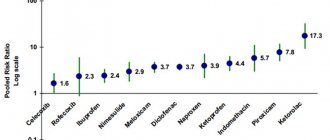Flatulence: norm and pathology
The human gastrointestinal tract, in addition to solid and liquid components, contains a gaseous component in quite significant volumes. Intestinal gases are distributed in a more or less dense mass of chyme and are enclosed in bubbles of various sizes coated with mucus. Increased gas content in the intestines and associated clinical disorders are included in the concept of “flatulence”. An increase in the volume of intestinal gases can lead to symptoms that cause the patient very noticeable discomfort in the form of a feeling of fullness in the abdomen, rumbling and pain. An enlarged abdomen and increased passing of gas may also be observed. Severe flatulence can disrupt a person’s normal lifestyle, significantly affect his mental state, and lead to restlessness, anxiety and even depression. In children of the first year of life, flatulence can lead to disruption of the child’s sleep and nutrition, and affect psychomotor and physical development.
Normally, the intestines of an adult contain about 200 ml of various gases. The composition of these gases is very variable: they include nitrogen (11–92%), oxygen (up to 11%), carbon dioxide (up to 50%), hydrogen (up to 10%), methane (up to 60%), hydrogen sulfide (up to thirty%). ammonia and some others.
A relatively large proportion of gases enter the intestines during swallowing, including nitrogen, oxygen and carbon dioxide. Increased gas in the intestines may be associated with increased swallowing of air (aerophagia) during meals, which is facilitated by rushed eating, talking while eating, drinking through a straw, and chewing gum. A large amount of carbon dioxide enters the gastrointestinal tract with carbonated drinks. Some carbon dioxide may be formed in the stomach as a result of the reaction of food carbonates with hydrochloric acid in the gastric contents. In children in the first months of life, swallowing increased volumes of air during feeding is often observed and is associated with insufficient maturity of the nervous system and an incompletely formed swallowing reflex (especially in premature and immature children at the time of birth), which can cause regurgitation and even excessive vomiting only what food was eaten. Perinatal disorders of the central nervous system also contribute to dyskinesia of the digestive organs, one of the manifestations of which may be aerophagia. In this regard, in order for excess air to escape from the stomach without taking its contents with it, it is recommended that infants be kept in an upright position for some time after feeding. Aerophagia, caused by dietary habits, is relatively physiological and can be fairly easily corrected. At the same time, aerophagia as a symptom of a serious disease of the nervous system and/or digestive organs may require both serious examination and long-term treatment.
Most of the gases from the stomach enter the intestines along with food.
The second important source of intestinal gases is the metabolic activity of intestinal microorganisms, most actively present in the colon. The saccharolytic microflora that predominates in the intestine under normal conditions largely utilizes carbohydrates that are not digested and not absorbed in the small intestine for their energy needs. First of all, we are talking about dietary fiber and some oligo- and disaccharides. As a result of fermentation processes, the microbe receives ATP, and its environment (i.e., intestinal contents) receives a number of metabolites, including gaseous ones.
Thus, as a result of homofermentative lactic acid fermentation, characteristic of lactobacilli and streptococci of the colon, lactic acid (up to 90%), carbon dioxide, hydrogen, and water are predominantly formed. Heterofermentative lactic acid fermentation, in which, in addition to lactic acid, other metabolites (including acetic acid) are formed, is characteristic of bifidobacteria. Alcoholic fermentation, leading to the formation of carbon dioxide and ethanol, is a side metabolic pathway in some representatives of lactobacilli and clostridia. Certain strains of Escherichia coli and clostridia obtain energy as a result of formic acid, propionic acid, butyric acid, acetone butyl or homoacetate types of fermentation. In this case, volatile fatty acids, carbon dioxide, hydrogen and water are formed during all fermentation options. Organic acids are utilized by macroorganisms, carbon dioxide is largely converted by other microorganisms into acetate, hydrogen is mainly absorbed and excreted through the lungs. Increased excretion of hydrogen with exhaled air is observed with an increase in the microbial population or with an increase in its saccharolytic activity, for example, with lactase deficiency.
Methane can form in small quantities in the intestines. Its presence in intestinal gases indicates the presence of Methanobrevibacter smithii in the intestinal microbiocenosis. Microbial metabolism of sulfur-containing compounds, primarily proteins (in particular, mucus proteins) causes the presence of hydrogen sulfide, but its high concentrations are associated with excessive activity of the proteolytic flora, often as a result of disruption of the processes of digestion and absorption in the small intestine and the entry of undigested proteins into the large intestine . Also, as a result of microbial metabolism of proteins, ammonia is formed, which easily diffuses through the intestinal wall into the blood of the portal system and is mainly retained by the liver. Normal intestinal microflora helps reduce the diffusion of ammonia into the blood by lowering the pH in the lumen of the colon, as a result of which ammonia is ionized to form ammonium ions, which are bound into salts and excreted in the feces.
Finally, some gases enter the intestinal lumen from the blood, but their volumes are relatively small.
The gas contained in the intestines is mainly evacuated through the anus, although some of it is absorbed into the blood and excreted through the lungs or utilized by the body. A healthy adult person excretes 0.2–2.5 liters of gases per ani during 5–15 passages per day [1, 2].
The main reason for the increased content of gases in the intestines is the increased metabolic activity of the intestinal microflora. Among the physiological reasons for this phenomenon, it should be noted the consumption of fiber-rich foods of plant origin, as well as raisins, beans, peas, black bread, kvass, and beer. Gas formation also increases in many pathological conditions that lead to disruption of the composition of the intestinal microbiocenosis.
An increased content of gases in the intestines leads to intestinal distension, thereby stimulating peristalsis, causing pain symptoms. At the same time, there is no clear correlation between the content of gases in the intestines and the clinical manifestations of flatulence, which is associated with significant individual variability in interoreception. In patients with a low response threshold of intestinal interoceptors, a pronounced clinical picture can be observed with minor gas formation, and in individuals with a high response threshold, complaints are not noted even with significant gas formation in the colon [3, 4].
Changes in the composition of the intestinal microbiocenosis and, as a consequence, the development of flatulence can be facilitated by disruption of the processes of digestion and absorption, as well as changes in intestinal motility. Essentially, with almost any disease of the digestive system, intestinal dysbiosis and flatulence can be observed as a manifestation of the latter.
A common cause of flatulence is lactase deficiency, an intolerance to the milk sugar lactose resulting from a deficiency of the small intestinal enzyme lactase. Normally, lactase breaks down milk sugar into glucose and galactose, which are absorbed into the blood in the small intestine, but with lactase deficiency, milk sugar is not broken down and reaches the colon unchanged, where it is utilized by microorganisms with an increase in gas production. In this regard, one of the tests to detect lactase deficiency is to determine the increased concentration of hydrogen in exhaled air. In addition, undigested lactose in the colon stimulates the secretion of water, which causes the development of loose, foamy stools with a sour odor. All of these symptoms occur only when consuming dairy products containing lactose, primarily whole milk. Fermented milk products contain less milk sugar and can be eaten with a slight decrease in lactase activity. Cottage cheese and cottage cheese do not contain lactose, and their consumption does not cause symptoms. Lactase deficiency can be primary, associated with the genetic characteristics of the individual and inherited, and secondary, that is, arising against the background of diseases of the small intestine, as well as constitutional. The latter is due to the fact that in some people (clinically healthy!) lactase activity in the small intestine decreases with age and they no longer tolerate dairy products. This process can begin as early as the second half of the first year of life and is not considered pathological. There are entire regions and continents in the world (for example, Africa), the adult population of which does not tolerate milk sugar.
Another common cause of flatulence is irritable bowel syndrome (IBS), which is manifested by a combination of abdominal pain with a change in bowel habits and/or flatulence. IBS refers to a group of functional disorders of the digestive system, in which the nervous and/or humoral regulation of gastrointestinal motility is impaired, and organic intestinal pathology is not detected. One of the causes of IBS may be a disorder of the intestinal nervous system, expressed in a decrease in the sensitivity threshold of intestinal interoreceptors. Clinical signs in favor of IBS include variability and diversity of complaints, lack of progression, normal weight, increased complaints during stress, absence of symptoms at night, and association with other functional disorders. Most often, pain occurs before defecation and goes away after it.
The main clinical manifestations of IBS include abdominal pain or discomfort for at least 3 months of the last year, which is relieved by bowel movements, accompanied by changes in stool frequency (more than 3 times a day or less than 3 times a week) and/or shape. stool (either hard, dry lumps - like “sheep feces”, or unformed - mushy). In addition to the main ones, there are also additional symptoms: difficulty in defecation or a feeling of incomplete emptying of the rectum, copious mucus secretion, rumbling or bloating.
Based on the nature of stool, there are three main clinical variants of IBS: IBS with pain and flatulence; IBS with constipation; IBS with diarrhea. Flatulence can be observed with any type of IBS, but is most pronounced with the first.
The cause of flatulence in IBS is a violation of intestinal motility, which leads to a change in the composition of the intestinal contents and, as a consequence, the composition of the intestinal microflora. Under certain conditions, the gas-forming activity of the latter increases, which clinically manifests itself in the form of flatulence [3, 4]. On the other hand, it has been shown that the reason for the development of the feeling of “bloating” in the abdomen in IBS may be not only and not so much increased gas filling of the intestines, but a slowdown in intestinal motility. One of the reasons for this slowdown may be a violation of the reflex regulation of motility at the level of the intestinal nervous system, in particular, a violation of the intestinal distension reflex [5, 6].
To effectively eliminate flatulence, you need to understand the reason that causes it. Very often, flatulence is associated with the patient’s dietary habits and regimen, which in most cases can be eliminated. In this regard, regular nutritious meals in a calm environment should be recommended. It is advisable to include Activia probiotic fermented milk products in the diet. Their regular use helps restore the composition and metabolic activity of intestinal microflora, as well as normalize intestinal motor function [9]. In controlled clinical studies, it was shown that regular consumption of these products for 14 days was accompanied by a decrease in the severity of bloating, flatulence, and the appearance of regular (at least 6 times a week) independent bowel movements [10]. The amount of gas-forming products must be selected individually. When gastrointestinal diseases are detected, these diseases should be treated first. The diet for flatulence is determined by the underlying pathological process. In case of lactase deficiency, it is mandatory to follow a lactose-free or low-lactose diet with the exclusion or reduction of milk sugar in the diet. For children of the first year, in this case, low-lactose milk formulas or special lactase preparations should be used. In case of IBS with flatulence, the amount of products of plant origin should be temporarily reduced, it is necessary to consult with a neurologist and psychologist, and antispasmodics can be used as a symptomatic remedy to eliminate pain (in older children and adults, for example, Duspatalin).
In order to correct the composition of the intestinal microflora, the administration of probiotics is indicated - preparations containing live microorganisms that have a positive effect on the microbial balance of the intestine. These preparations may contain Lactobacillus acidophilus, Lactobacillus GG, Lactobacillus fermentum, Streptococcus (Enterococcus) faecium SF68, S. termophilus, Bifidobacterium bifidum, for which the probiotic effect has been proven in double placebo-controlled studies. It is desirable that the strains of microorganisms included in the preparations have antibiotic resistance and are protected from acidic gastric contents. On the other hand, correction of intestinal microbiocenosis can be effectively carried out with prebiotic drugs, the most common component of which is lactulose (Duphalac). Low doses of lactulose help restore intestinal microflora in case of intestinal dysbiosis of various origins, by stimulating the growth of “own” microflora. Doses of the drug Duphalac are selected individually and vary depending on age, and can be divided into two doses (table). In real practice, the combined use of pre- and probiotics is often used.
As an additional means to eliminate the symptom of flatulence and alleviate the patient’s condition, preparations containing simethicone, a mixture of dimethsiloxane polymer with silicon dioxide, have been widely used for many years. Simethicone is insoluble in water, quickly spreads across the media interface and displaces foaming agents from the surface layer of the film. At the same time, it destroys the membranes of gas bubbles in the intestinal contents and promotes the removal of gases from the intestines. Simethicone quickly and effectively eliminates signs of increased gas filling in the intestines, has no side effects and no age restrictions. The effectiveness and safety of simethicone has been proven in a number of studies, and drugs based on it are recommended for use in many conditions accompanied by flatulence, in particular, in functional disorders [7, 8]. Since in almost all cases of flatulence there are disturbances in the digestive processes, it is advisable to combine simethicone with pancreatic enzymes, which significantly increases the effectiveness of eliminating flatulence. Enzymatic drugs can be prescribed independently (for example, Creon) or as part of drugs combined with simethicone (Pankreoflat).
The positive effect of pancreatic enzymes is due to an improvement in digestion processes, which is reflected in the functional state of the intestinal microflora and a decrease in the entry into the colon of underdigested, in particular, gas-forming components. The use of microspherical preparations (Creon) turns out to be more effective compared to conventional tablet preparations, firstly, due to the high degree of activity of the original substrate (pancreatin), and secondly, the special dosage form of the drug (microspheres 1–1.2 mm in size) , ensuring uniform mixing with gastric contents; thirdly, a pH-sensitive shell of microspheres, protecting the enzyme from destruction in the stomach and ensuring its maximum release in the duodenum [10–13].
Creon should be taken with meals. The dose is selected individually, the daily dose depends on the severity of exocrine pancreatic insufficiency. In pediatric practice, to make it easier to take the drug, the capsule can be carefully opened and the microspheres can be taken without chewing, with a small amount of water. If microspheres are mixed with food, they should be taken immediately after mixing; otherwise, damage to the enteric coating may occur.
Thus, increased gas formation can be associated with a wide variety of reasons and, therefore, the approach to correcting this condition should be strictly individual. In general, the main directions of this correction are diet therapy, treatment of the underlying disease (if one is identified), correction of microbiocenosis and symptomatic therapy with the inclusion of drugs containing simethicone.
For questions regarding literature, please contact the editor.
A. A. Kovalenko , Candidate of Medical Sciences T. V. Gasilina , Candidate of Medical Sciences S. V. Belmer , Doctor of Medical Sciences, Professor of the Russian State Medical University , Moscow
Legumes
Photo by Shelley Pauls / Unsplash
Beans, lentils, chickpeas, peas and other legumes contain galacto-oligosaccharides (GOS) and fructans - dietary fibers that the human body cannot break down on its own. But intestinal bacteria do an excellent job of this task and love these foods very much, but in the process of breaking them down they release gases.
The intensity of gas formation varies from person to person and depends on the bacteria: some people produce more gases than others. If you suddenly add a lot of plant fibers, including legumes, to your diet, gas formation increases, but with regular consumption of these products, this side effect is reduced. Because of this, switching to veganism or vegetarianism is associated with increased gas formation.
Everything you need to know about fiber
People with irritable bowel syndrome (IBS) are more susceptible to discomfort caused by gas, so some nutritionists recommend eating a diet low in GOS and fructans, including legumes.
If your diet contains almost no legumes, you should introduce them gradually. To start, you can add some lentils or a few beans to a salad, or spread some hummus on a sandwich. This way you can avoid increased gas formation.
Symptoms of bloating
Excess gas in the digestive system is manifested by general discomfort and some unpleasant symptoms:
- pain and heaviness in different parts of the abdomen or throughout its entire area;
- loud sounds in the stomach, a feeling of constant movement in it;
- release of gas with an unpleasant odor, accompanied by loud sounds.
Sometimes there are complaints of frequent belching with an unpleasant aftertaste, heartburn, indigestion, sleep problems, and emotional instability.
Subjective sensations depend on the specific area of the digestive tract in which gases accumulate. If the delay occurs in the area of the splenic flexure, then the complaints are associated with pain in the left hypochondrium, radiating to the heart, and general bloating. Accumulation in the area under the liver is manifested by pain in the right hypochondrium and a feeling of fullness in the stomach.
Flatulence of the small intestine is characterized by general bloating of the abdomen, and of the large intestine - on the sides.
Products containing inulin
Photo by Burhan Rexhepi / Unsplash
Inulin, a plant fiber that is indigestible by the human body, is one of the favorite treats of good gut bacteria. But, as we wrote earlier, the joy of bacteria is often accompanied by the release of large amounts of gases.
Inulin is a prebiotic that increases the number of good bacteria such as Lactobacillus and Bifidobacteria. Intestinal bacteria then convert it into butyrate, a fatty acid that supports the health of the intestinal mucosa.
Inulin improves the absorption of magnesium and calcium - microelements that support bone health, nerve and muscle function.
Research shows that it also lowers blood sugar and helps control appetite. However, when inulin ferments, microorganisms also produce gases, which can cause bloating and cramping, especially if you eat too much of this fiber. According to research, the daily intake of inulin for healthy people is 10 grams.
Suddenly adding large amounts of fiber, including inulin, will likely cause bloating and gas. Therefore, any dietary fiber should be introduced into the diet gradually, and over time, side effects such as bloating and gas will decrease.
Products containing inulin:
| Product (100 g) | Inulin content (g) |
| Chicory root | 35,7–47,6 |
| Garlic (dried) | 20,3–36,1 |
| Jerusalem artichoke | 16,0–20,0 |
| Garlic (raw) | 9,0–16,0 |
| Asparagus | 2,0–3,0 |
| Onion | 1,1–7,5 |
| Bananas | 0,3–0,7 |
Remember, fiber should be taken with plenty of water to avoid constipation.
Gluten containing products
Photo by Angelo Pantazis / Unsplash
Wheat, barley, rye and their products contain gluten. This is a protein that causes increased gas formation in people with celiac disease - gluten intolerance. When gluten enters the gastrointestinal tract of a person with celiac disease, it causes an autoimmune reaction, which is accompanied by bloating and abdominal pain, as well as diarrhea.
Gluten sensitivity without celiac disease is another gluten-related condition in which the protein causes gas but without intestinal damage. Research shows that some gut bacteria break down gluten into particles that trigger an immune system response, which may be one reason for these side effects.
Can a genetic test detect gluten intolerance?
The only way to reduce your immune system's reaction to gluten-containing foods is to eliminate them from your diet. But despite the popularity of gluten-free diets, you should be very careful with them. The symptoms of celiac disease are similar to the symptoms of other diseases and inflammations of the gastrointestinal tract, therefore, entire food groups can be excluded from the diet only as directed by a doctor and under his supervision.
Abruptly avoiding grain products can lead to nutritional deficiencies and cause microbiota imbalance. And this can even aggravate the problem of increased gas formation. Always consult your doctor or nutritionist before making major changes to your diet.
The Atlas genetic test will help you find out if you are predisposed to lactose and gluten intolerance.
Where does bloating occur?
Bloating occurs in different parts of the digestive tract.
In the stomach
The stomach always contains a certain amount of air that enters it during meals. The natural mechanism for getting rid of excess air is belching; the remaining volume enters the small intestine.
The stomach contains mainly nitrogen and oxygen - gases contained in the atmosphere and have no odor. An unpleasant odor occurs when gases pass through the small and large intestines.
In the small intestine
In the small intestine, gas bubbles combine with liquid digested food and are absorbed through its mucous membrane.
In the duodenum (the initial part of the small intestine), the reaction of hydrochloric acid with alkali produces carbon dioxide. Under normal conditions, most of the carbon dioxide is absorbed into the blood, and the rest passes further into the large intestine. When carbon dioxide is produced in excess, it is retained in the small intestine, causing bloating.
In the large intestine
Feces accumulate in the large intestine, and gases are not absorbed into the blood. They can only come out through the rectum. Depending on the volume of gas accumulated in the colon, it is released at different frequencies.
Gases affect the functioning of the large intestine in different ways. Thus, an excessive amount of methane in the gas composition leads to constipation, because methane impedes the movement of feces through the rectum. An increased concentration of hydrogen negatively affects motility, but activates movement in the lower parts of the colon.
When there are problems with digestion and undigested food enters the large intestine, the compounds indole and skatole are formed. When they combine with hydrogen sulfide, they acquire a sharp, unpleasant odor.
Cruciferous
Photo by Christophe Dion / Unsplash
Cruciferous vegetables like broccoli and cauliflower are common foods that are associated with bloating and gas. When cooked and chewed, these plants release glucosinolates, sulfur-containing organic compounds.
Research shows that many gut bacteria ferment glucosinolates into ferrous sulfates and ferrous ions. In the future, these substances can turn into hydrogen sulfide, which causes the gases to acquire an unpleasant odor.
On the one hand, glucosinolates feed probiotic bacteria that naturally live in the human intestines. These bacteria include Lactobacillus and Bifidobacterium. On the other hand, a gut with too many sulfate-reducing bacteria like Desulfovibrio can increase the production of hydrogen sulfide, which causes a particularly unpleasant odor.
Using the Atlas Microbiota Test, you can find out if you have too many Desulfovibrio bacteria in your gut, which are responsible for producing hydrogen sulfide.











